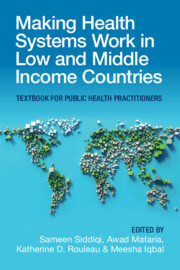 Making Health Systems Work in Low and Middle Income Countries
Making Health Systems Work in Low and Middle Income Countries from Section 2 - Transforming Health Systems: Confronting Challenges, Seizing Opportunities
Published online by Cambridge University Press: 08 December 2022
Meant for public health professionals, the Chapter explains what is meant by political economy and its relevance to health, why structural reforms in health are frequently influenced and obstructed by political considerations, how political expediency influences priority setting decisions in health that are frequently related to allocation of resources, and what measures can be taken to minimize political obstacles and barriers in favour of evidence-informed decisions. Political economy of health, as a field of study, grew rapidly in the 1970s that sought to explain the disparities in health care access and the socioeconomic differential in health status across society. Health system development, reform and transformation is a social and political intervention. Political economy analysis (PEA) is central to the successful formulation of health policies and plans and for ensuring their effective implementation. PEA can help to identify potential barriers and facilitators for policy and system change. PEA can help to identify potential barriers and facilitators for policy and system change.
To save this book to your Kindle, first ensure [email protected] is added to your Approved Personal Document E-mail List under your Personal Document Settings on the Manage Your Content and Devices page of your Amazon account. Then enter the ‘name’ part of your Kindle email address below. Find out more about saving to your Kindle.
Note you can select to save to either the @free.kindle.com or @kindle.com variations. ‘@free.kindle.com’ emails are free but can only be saved to your device when it is connected to wi-fi. ‘@kindle.com’ emails can be delivered even when you are not connected to wi-fi, but note that service fees apply.
Find out more about the Kindle Personal Document Service.
To save content items to your account, please confirm that you agree to abide by our usage policies. If this is the first time you use this feature, you will be asked to authorise Cambridge Core to connect with your account. Find out more about saving content to Dropbox.
To save content items to your account, please confirm that you agree to abide by our usage policies. If this is the first time you use this feature, you will be asked to authorise Cambridge Core to connect with your account. Find out more about saving content to Google Drive.